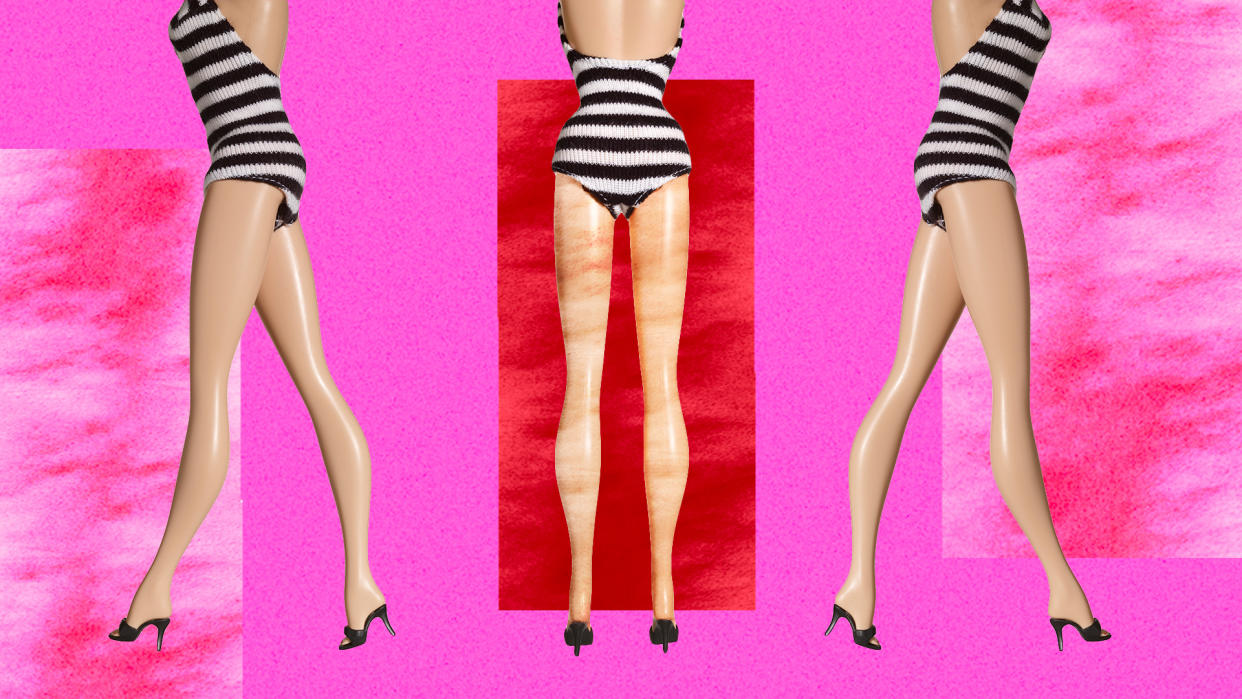Barbie has cellulite in the 'Barbie' movie — and so do most women. Here's why it's normal to have dimpled skin.

In the Barbie movie world, Barbie has cellulite.
Greta Gerwig’s highly-anticipated film features Margot Robbie as the titular doll who goes through a major existential crisis — and it involves finding a patch of cellulite on her once supposedly “perfect” plastic skin.
Barbie’s body image controversy
Barbie with cellulite is something that many people who grew up playing with the doll would never expect. After all, Barbie, which debuted in 1959, has been the subject of much scrutiny over the years for her body, from her impossibly tiny waist to her generally disproportionate body. (If Barbie was a real person, she would be six feet tall, with an 18-inch waist, and 33-inch hips.)
There are real reasons to be concerned: 2006 research published in the journal Developmental Psychology suggested that girls exposed to Barbie became more concerned with thinness, while in 2021, research published in the journal Body Image suggested that playing with ultra-thin dolls, like Barbie, reduced girls’ ideal body size.
Yet Barbie is not just an impossibly tall, impossibly thin blonde anymore: in 2016, Mattel did the biggest update to their Barbie line by creating more variety in body type, skin tones and style. In a recent interview for Variety’s podcast Just for Variety, model Ashley Graham spoke about how Mattel created a Barbie in her likeness that same year.
“The first things that came to mind were thick thighs, lower belly fat, round arms [and] cellulite,” Graham recalled. “And I got to do everything except for the cellulite. … Maybe it was too hard to figure out how to do that with the computer.”

Gerwig’s version of the doll, of course, now has cellulite — and finally, Barbie is facing some of the same body insecurities that many people once said Barbie perpetuated in themselves.
However, when it comes to cellulite, there’s no reason for Barbie to feel insecure — or anyone else, for that matter.
What is cellulite?
Cellulite is a skin condition that leaves the appearance of dimpled, lumpy skin — and it’s very, very common.
"Cellulite is an exceedingly common concern for women, affecting 80 to 90 percent of women and approximately 10 percent of men," Long Island-based plastic surgeon Stephen T. Greenberg, M.D., told Shape in 2023. "Cellulite is considered normal.”
Not much is known about what causes cellulite. According to the Mayo Clinic, it’s all about the fibrous connective cords that connect skin to the muscle beneath it, with fat lying between. As fat cells accumulate, they press against the skin. That is what creates the appearance of dimpling.
What causes cellulite?
According to VeryWell Health, skin structure, hormones, genetics, and age play the biggest role. It’s important to note that even very fit people can have cellulite, and that while the appearance of cellulite may worsen as you gain weight, the amount of fat in one’s body does not cause cellulite.
The reason significantly more women than men have cellulite is partially due to the fact that genetically, women make more of the hormone estrogen. The hormone estrogen plays a particularly prominent role in cellulite, as it causes fat to naturally build up in the breasts, thighs, and buttocks — where cellulite is most common. This is especially true for women during their childbearing years, and you may be more likely to develop cellulite in particularly high-estrogen states such as pregnancy and nursing.
Yet because there are so many factors that contribute to cellulite, there is no one reason why it develops. For example, it often becomes more difficult for women to lose weight after going through menopause, which can exacerbate cellulite as well. Lower estrogen can also lead to impaired circulation, which is a contributing factor of cellulite as well.
There are other factors that may increase the likelihood of cellulite as well, including low muscle tone, smoking, poor nutrition, and poor skin health.
What can I do about cellulite?
Yes, there are creams on the market that claim to tighten skin and reduce the appearance of cellulite, but the reviews are mixed on what actually works. (There’s actually a Barbie movie collaboration body butter that claims to “boost collagen and plumps out creases in the skin,” which some have argued is profiting on the very body ideals that Barbie claims to push back against.)
The ways to combat cellulite are things that are generally good for your health, such as not smoking, maintaining a balanced diet, and strength training. Just remember that even if you are doing all of these things, you may still find yourself with cellulite.
It’s OK to feel insecure about your dimpled skin, but it’s important to note that we aren’t made of plastic — and cellulite is normal, and most likely inevitable.
